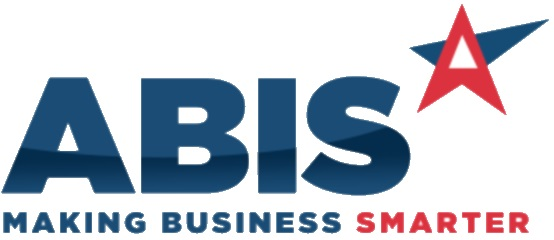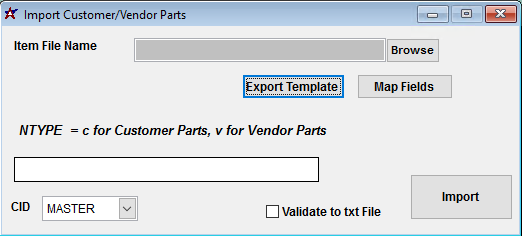Difference between revisions of "Item OHF Min/Max Import Guide"
From Adjutant Wiki
m (Freddy moved page Item DET Import Guide to Item OHF Min/Max Import Guide) |
|||
| Line 63: | Line 63: | ||
Required fields are indicated with an * | Required fields are indicated with an * | ||
| − | '''*f1 - Item''' - Item Master item code for the associated | + | '''*f1 - Item''' - Item Master item code for the associated OHF record. The item code must exist in Adjutant, or it will fail validation. |
| − | '''*f2 - | + | '''*f2 - Whse''' - Inventory warehouse name |
| − | ''' | + | '''f3 - LeadTime''' - Vendor order lead time in days. |
| − | '''f4 - | + | '''f4 - OrderInc''' - Vendor order increment in purchase units. |
| − | '''f5 - | + | '''f5 - Min''' - |
| − | '''f6 - | + | '''f6 - Max''' - |
| − | '''f7 - | + | '''f7 - OrderQty''' - |
| − | '''f8 - | + | '''f8 - ScrapAtQty''' - |
| − | '''f9 - | + | '''*f9 - HeldFor''' - |
| − | '''f10 - | + | '''*f10 - Owner''' - |
| − | '''f11 - | + | '''f11 - Bin''' - ProBin |
| − | '''f12 - | + | '''f12 - PWOBin''' - |
| − | '''f13 - | + | '''f13 - CtrlAcct''' - |
| − | '''f14 - | + | '''f14 - POAcct''' - |
| − | '''f15 - | + | '''f15 - ICCAcct''' - |
| + | |||
| + | '''f16 - WIPAcct''' - | ||
| + | |||
| + | '''f17 - ItemCat''' - | ||
| + | |||
| + | '''f18 - BCost''' - | ||
| + | |||
| + | '''f19 - BQty''' - | ||
| + | |||
| + | '''f20 - PSelCode''' - | ||
| + | |||
| + | '''f21 - StkCode2''' - | ||
| + | |||
| + | '''f22 - OrderFreq''' - in days | ||
| + | |||
| + | '''f23 - IncReOrder''' - | ||
| + | |||
| + | '''f24 - FixReOrder''' - | ||
| + | |||
| + | '''f25 - ProdPlant''' - | ||
| + | |||
| + | '''f26 - Consig''' - | ||
| + | |||
| + | '''f27 - CycleCode''' - | ||
| + | |||
| + | '''f28 - DefSource''' - | ||
| + | |||
| + | '''f29 - AvgCost''' - | ||
| + | |||
| + | '''f30 - LastCost''' - | ||
| − | |||
| − | |||
| − | |||
| − | |||
| − | |||
| − | |||
| − | |||
Revision as of 12:46, 7 December 2018
Contents
- 1 General Import Template File Notes
- 2 Customer/Vendor Parts Import Notes
- 3 Customer/Vendor Parts File Data Scrubbing
- 4 Customer/Vendor Parts Import Screen (IMPORTVPART)
- 5 Customer/Vendor Parts File Definitions
- 6 Customer/Vendor Parts Additional Steps
- 7 Customer/Vendor Parts Reconciliation
- 8 Customer/Vendor Parts Database Tables
General Import Template File Notes
- Template files are typically generated from their respective Import screen using an 'Export Template' button.
- Using the 'Export Template' button from an updated system will help ensure that you are using the most up-to-date import file, and will help avoid errors.
- Templates generally (but not in all cases) contain 3 rows of header information.
- The first row is generally labelled with f1 through f## and is used to give a consistent column id to each data column. Do not remove this row unless instructed.
- The second row is labelled with the column data/field name. The values in this row are used for the file mapping screen. Editing these values is generally not needed and may make the field mapping process difficult.
- The third row (if present) is labelled either with the same values from row 2, or with more detailed field descriptions. The third row is available to create a customer-friendly name for the associated data column.
- The third row should be removed from the source file prior to importing. It will cause errors since it will be treated as the first import record on the file.
- Import files MUST always be saved as 'Microsoft Excel 5.0/95 Workbook (*.xls)' format until further notice. The import screens will generate errors if the file type is not correct.
- It is a good idea to perform a Mapping Table Import using a current source list before beginning on any imports. Without a current mapping table, the quality of imports can be compromised. The Mapping Table Import only needs to be run once on a newly set up Adjutant system. It does not need to be run before each import.
- Export a current list from the Mapping Table Import screen from an updated system (or contact your Implementation Consultant for an updated file).
- Perform a Mapping Table Import on the target system with the XLS file from the step above.
Customer/Vendor Parts Import Notes
The Customer/Vendor Parts Import is used to set the alternate vendor or customer part number details for Adjutant item codes. The Customer/Vendor Parts Import is most commonly used to set the vendor associations for items ordered through the QuickBuy application, and to set the default order source for items.
Timing and Preparation
The Customer/Vendor Parts Import can be run any time after the Item Master import.
General Notes
Most of the order calculation criteria has been moved to the item OHF tab, which offers more control over the order calculations used for QuickBuy procurement. The [Item DET Import Guide|Item DET Import file] shoudl be used to update order calculation details for the QuickBuy application.
The import can be used to update existing customer or vendor alternate part numbers when an exact match is found for the Item/VendNo combination. However, if a new customer/vendor part is imported and any of the other details in the import file differ, the import process will create a new record rather than update the existing record. If you are attempting to update/replace the alternate part numbers, do not fill in any of the other non-required fields on the import file.
Customer/Vendor Parts File Data Scrubbing
Every customer's data will have different issues that need addressing. Some of the issues will not make themselves visible until after the data has been imported and is in use during parallel testing. This is why it is critically important to perform an early import, and keep accurate notes on issues that need to be addressed on a supplemental import, or for a complete re-import.
This file is generally built from various sources of customer supplied data, so there is rarely a need for scrubbing customer data, except when item codes or vendor numbers are changed from the customer's legacy system.
Customer/Vendor Parts Import Screen (IMPORTVPART)
Menu Location: Transaction>>Importers/Exporters>>Item Control>>Vendor Part Import
File Name(Header)/Browse: Use the Browse button to locate and select the completed Customer/Vendor Parts import template file (in XLS format).
Export Template: Generates a blank Customer/Vendor Parts template file
Map Fields: Fields must be mapped prior to importing. If no changes have been made to the column headings, the mapping screen should show all green, and you can click OK to continue. If any of the Input Field Name columns on the left are red, single-click on the line on the left column, and then double-click the desired mapped field in the right column to complete the mapping. Repeat for any red lines on the left that should be mapped. If there are additional columns in the source file that should NOT be mapped, they can be left unmapped (displayed in red). Mandatory fields will require that they be mapped before clicking OK.
Validate to XLS File: Generates a TXT file of errors that will prevent the import from completing.
Customer/Vendor Parts File Definitions
Required fields are indicated with an *
*f1 - Item - Item Master item code for the associated OHF record. The item code must exist in Adjutant, or it will fail validation.
*f2 - Whse - Inventory warehouse name
f3 - LeadTime - Vendor order lead time in days.
f4 - OrderInc - Vendor order increment in purchase units.
f5 - Min -
f6 - Max -
f7 - OrderQty -
f8 - ScrapAtQty -
*f9 - HeldFor -
*f10 - Owner -
f11 - Bin - ProBin
f12 - PWOBin -
f13 - CtrlAcct -
f14 - POAcct -
f15 - ICCAcct -
f16 - WIPAcct -
f17 - ItemCat -
f18 - BCost -
f19 - BQty -
f20 - PSelCode -
f21 - StkCode2 -
f22 - OrderFreq - in days
f23 - IncReOrder -
f24 - FixReOrder -
f25 - ProdPlant -
f26 - Consig -
f27 - CycleCode -
f28 - DefSource -
f29 - AvgCost -
f30 - LastCost -
Customer/Vendor Parts Additional Steps
There are no additional steps needed after the import.
Customer/Vendor Parts Reconciliation
Reconciling imported data should begin with spot-checking several records field-by-field for complete data import. Pick records from the source file that have the most data columns filled in. Verify that all source file data fields imported correctly and display as expected.
Customer/Vendor Parts Database Tables
VPART - Customer/Vendor parts data is store in the VPART table according to IKEY and VENDID combination. Customer part numbers and Customer numbers are stored in the VPARTNO and VENDID fields.

